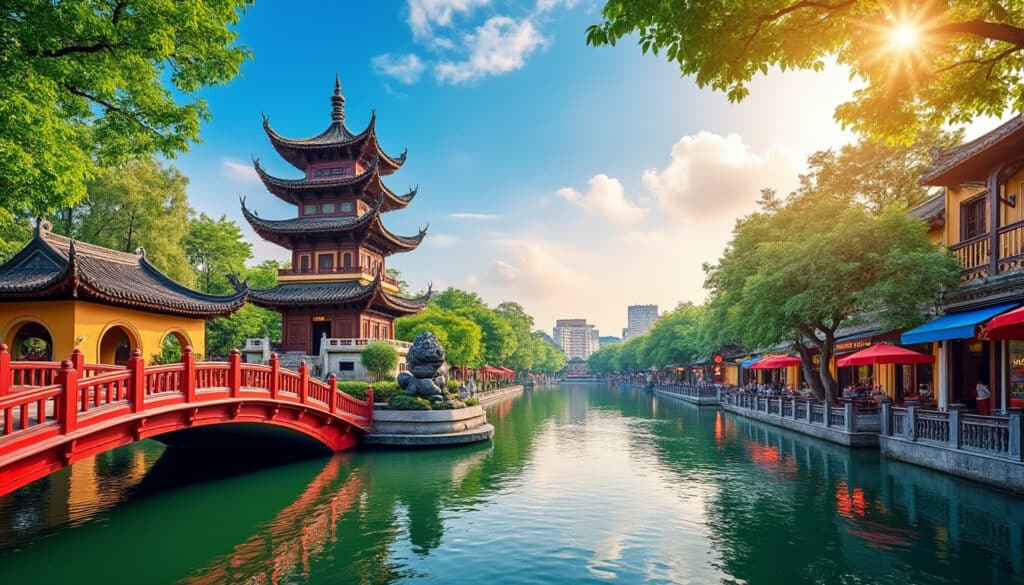As the capital city of Vietnam, Hanoi’s reputation and identity intertwine richly with its historical and cultural legacies. Emblematic for its historic architecture, street food, and melodious water puppet shows, the city pulsates with the quintessential Vietnamese spirit. From its vast political shifts to the artistic strokes of its craftsmen, Hanoi is a tapestry woven with layers of tradition and modern growth. Let’s dive into the essence of Hanoi’s vibrant lifestyle, traditions, and the distinctive Hanoi Spirit.
Hanoi’s Historical Tapestry: A Walk Through Time
Hanoi, the heart of Vietnam, is more than just its political capital. It’s a living museum with over a thousand years of history, offering a window into the country’s tumultuous yet fascinating past. At its core, the city’s history is intertwined with the history of Vietnam itself. From the ancient Son Vi culture to the resilient narratives of colonial struggles and revolutions, Hanoi has been a key stage for the unfolding of Vietnam’s historical drama.
🚶♂️Exploring the history of Hanoi is akin to taking a historical journey. The city was established as the political and cultural center of Vietnam during the Thục Dynasty when Co Loa was declared as the capital. The transition from Co Loa to Thang Long under the Ly Dynasty symbolized a new era, reflecting the city’s emergence as a hub of Vietnamese political power and culture. The Ly Dynasty marked the beginning of Hanoi’s transformation into a symbol of the country’s resurgence.
Interestingly, Thang Long, which means “Ascending Dragon,” was not just a name but a testament to the ambition and potential of Vietnam. The city flourished during the Ly and subsequently the Tran Dynasties, resisting invasions and establishing itself as a stalwart bastion of Vietnamese sovereignty. This era is epitomized by the victories over the Mongol invasions, showcasing unparalleled resilience and strategic prowess.
Legacy of the Ly and Tran Dynasties
The Ly Dynasty, initiated by Ly Thai To, is credited with laying the foundations of modern Hanoi. With the construction of numerous palaces, cultural institutions, and an intricate system of fortifications, it established a framework that would shape the city’s identity for centuries to come. 🏰 Moreover, it wasn’t simply about power; the era was marked by cultural and intellectual advancements, setting the stage for Hanoi’s future roles.
The Tran Dynasty continued this legacy. Perhaps their most remarkable achievement was the trilogy of victories against the Yuan Mongol invasions, reinforcing Hanoi’s strategic military significance. It’s during this period that the city’s identity as a resilient and powerful capital was solidified.
As the city transitioned through periods of Chinese, French, and Japanese occupations, its resilience was continually tested. The city’s spirit remained unbroken, and each invader’s influence was integrated into the melting pot that is Hanoi today. The French colonial era left behind architectural imprints still visible in Hanoi’s urbane landscapes, adding a layer of European charm to its eastern beauty. 🌍
Despite the tumult, the city never lost its cultural core, retaining a vibrant Vietnamese soul evident in the lifestyle and traditions of its people. Hanoi’s history is not just a linear timeline but a rich tapestry of cultural exchanges and amalgamations.
| Era | Key Developments |
|---|---|
| Thục Dynasty | Establishment of Co Loa as the capital |
| Ly Dynasty | Founding of Thang Long, military and cultural advancements |
| Tran Dynasty | Victories over Mongol invasions, continuation of Hanoi’s cultural legacy |
| French Colonial Period | Introduction of European architecture |
The Cultural Identity of Hanoi: A Blend of Old and New
The cultural identity of Hanoi is a vibrant mosaic that reflects the diverse historical influences it has absorbed over the centuries. Unique customs, festivals, and culinary traditions make up the fabric of Hanoi’s cultural identity, marking it as a city where ancient traditions meet contemporary lifestyle.
With its distinct customs, Hanoi stands out as a bastion of traditional Vietnamese culture. The city is known for its devotion to maintaining customs related to the Lunar New Year, or Tet, which includes traditional rituals such as giving lucky money and preparing special foods. These customs are not just formalities but are deeply ingrained practices that carry the Vietnamese soul.
The vibrant cultural festivals in Hanoi further highlight its unique identity. The Perfume Pagoda Festival and the Co Loa Temple Festival are perfect examples of how traditional practices are woven into the local lifestyle. These festivals are not just for celebration but serve as a mechanism for cultural preservation, educating younger generations about the importance of their heritage. Explore these and other Hanoi holidays here.
Traditional Hanoi Festivals: A Cultural Showcase
🌸 The Perfume Pagoda Festival is one of Vietnam’s biggest annual gatherings, inviting thousands of pilgrims to experience the harmonious blend of nature and spirituality. Encapsulating the Hanoi Spirit, this festival showcases a confluence of Buddhist, Taoist, and Confucian principles, reminding visitors of the diverse spiritual fabric of Vietnamese culture.
Meanwhile, the Co Loa Temple Festival encompasses a rich mixture of myth, legend, and history, bringing to life old tales and reiterating the city’s historical significance. Participants engage in traditional games such as wrestling and human chess, emblematic of Vietnam’s rich folklore and recreational heritage.

The culinary landscape in Hanoi is no less impressive. The city is renowned for its traditional dishes like Phở, which carry unique flavors that are locally cherished and internationally acclaimed. This dish, among others, illustrates the city’s rich tapestry of culinary arts, which continues to evolve while preserving its deep-rooted antique flavours.
Understanding Hanoi’s daily life offers a glimpse into how these cultural practices and culinary delights shape its unique cultural identity. The blend of old traditions with contemporary lifestyles shows Hanoi as a city that respects its past while embracing modernity.
The cultural essence of Hanoi is also defined by its artisans and craftsman community, who continue to keep alive traditional practices amidst the changing urban landscape. These crafts reflect the Hanoi Essence, a delicate yet vibrant narrative of skill and dedication.
Architectural Splendours of Hanoi: Ancient Foundations, Modern Vistas
Hanoi boasts a unique architectural blend that narrates stories of its rich heritage alongside contemporary growth. The city’s streets are a visual timeline, showcasing a progression from ancient traditions to modern skyscrapers.
The architecture of Hanoi is a culmination of various influences—indigenous Vietnamese architecture alongside Chinese and French colonial styles, creating a distinctive architectural profile unlike anywhere else. With ancient buildings like the Temple of Literature and the French charm of St. Joseph’s Cathedral, the city offers a diverse architectural palette that signifies its history.
Heritage Buildings and Modern Developments
🏛️ The Temple of Literature stands as a significant symbol of the city’s scholarly pursuit and respect for knowledge. As Vietnam’s first university, it emphasizes Hanoi’s long-standing commitment to education and culture.
Adjacent to these historical structures are modern developments that reflect the city’s rapid growth and adaptation to contemporary economic landscapes. High-rise buildings and cutting-edge structures symbolize Hanoi’s transition into a bustling urban metropolis while still respecting its historical roots. This balance is crucial as it helps maintain the unique blend of tradition and progress that characterizes Hanoi’s architectural identity.
The development of Hanoi is not merely about physical structures but also about embedding the Hanoi Spirit in every layer of urban expansion. This sustainable growth model ensures that the city retains its human essence amidst modernization drives.
Visitors can explore a blend of Hanoi’s ancient and modern elements, appreciating how the city has evolved while retaining its charm. The iconic streets of the Hanoi Old Quarter, for instance, narrate tales of commerce and culture. Complement this exploration by diving into the stories behind Hanoi’s Names and Flags, which further enrich the city’s narrative.
In essence, Hanoi’s architectural landscape is a testament to the city’s ability to adapt while preserving its robust cultural core. It reflects the city’s journey from its storied past towards a promising future, inviting visitors to partake in its legacy.
Vibrant Arts and Crafts Scene: The Soul of Hanoi Handcrafts
Hanoi is home to an array of traditional crafts that highlight the creativity and dedication of its artisans. This active hub of creativity continues to preserve the city’s heritage through its captivating art forms.
The vibrancy of Hanoi crafts is encapsulated in its handicrafts, pottery, silk weaving, and intricate lacquer goods. Bat Trang, in particular, stands out as a vital center of pottery, sustaining age-old techniques while innovating with modern designs. These crafts are not merely products but hold deeper cultural tales woven into their creation.
The Craftsmanship of Bat Trang
✨ Bat Trang’s reputation for excellence in pottery is renowned, with its pieces being sought after by collectors worldwide. The intricate skills involved in crafting each ceramic piece highlight a dedication to preserving a traditional art form, pivotal to Hanoi’s artistic identity.
Hanoi artisans continue developing these crafts, breathing life into Vietnam’s rich cultural narrative with each creation. These artisans, often seen working diligently in quaint workshops, contribute significantly to preserving the Ha Noi soul, highlighting craftsmanship that’s both innovative and deeply rooted in tradition.
Paintings, silk, and lacquerware complement Hanoi’s vibrant art scene, adding color and texture to its cultural offerings. Hanoi artisans and their crafts are integral to understanding the city’s essence, where each crafted piece reflects an artist’s soul and history.
| Craft | Description |
|---|---|
| Pottery | Intricate designs and high-quality ceramics crafted in Bat Trang |
| Silk | Luxurious silk weaving, a testament to exquisite skill |
| Lacquerware | Crafted using traditional techniques, rich in cultural significance |
| Painting | Vivid imagery found in traditional and contemporary styles |
Visitors are encouraged to engage with these crafts, to see the talent and devotion of the craftspeople, truly understanding how these arts contribute to the larger VietCulture and the Hanoi essence.
In celebrating this vibrancy, the Hanoi craft culture reveals a rich vein of historical continuity and artistic innovation waiting to be explored.
Hanoi’s Lifestyle and Modern Day Identity
Hanoi’s modern identity is woven from daily life interactions, local experiences, and a lifestyle that preserves tradition while embracing global culture. As Vietnam’s capital, it presents an intriguing mix of bustling commerce, serene parks, and vibrant street culture.
The Hanoi lifestyle is both dynamic and deeply traditional. While the city pulsates with the hustle of motorcycles and the chatter of marketplaces, it also offers tranquil moments in places like Hoan Kiem Lake and the numerous cafes that dot its landscape. These places offer locals and visitors alike a chance to savor the simplicity of Hanoi, embodied in its famed egg coffee and timeless architecture.
Café Culture and Vibrant Streets
☕ Hanoi’s café culture is a testament to its ability to blend the old with the new. Café Hanoi is not just about coffee; it’s an experience where heritage meets modernity. Whether it’s sipping on robust Vietnamese coffee or exploring culinary delights like banh mi, the city’s café culture reflects its evolving identity.
Street vendors, meanwhile, contribute to Hanoi’s unique landscape, offering a myriad of snacks that carry the flavors of Ha Long traditions. From the sizzling meats of bun cha to the refreshing sweetness of che, these interactions provide a taste of Hanoi that is both authentic and legendary.
The Hanoi demographics and geography further define its urban landscape, showing a city that includes a diverse populace, each contributing their own stories to the city’s vibrant narrative. This vibrant blend of people and culture ensures that Hanoi continues to be not just Vietnam’s heart but also its soul.
As Hanoi grows, it continues to balance the scales between preserving its rich legacy and being a beacon for progress. The Hanoi of today is a city of contrasts, where bustling modernity coexists with timeless soul—a city like no other.
In essence, Hanoi’s reputation and identity are shaped by its historical roots, cultural vibrancy, and modern-day evolution. Each visit to the city unfolds stories of Hanoi Essence that are as unique as they are intriguing.
FAQ: Common Queries about Hanoi
- 🌟What is the significance of Hanoi’s Old Quarter?
The Old Quarter is a cultural hub that reflects the historic heart of Hanoi, showcasing narrow streets that have stood for centuries. It’s an area where tradition meets tourism, offering a plethora of shops, eateries, and traditional crafts.
- 🌟What traditional dishes should I try in Hanoi?
Some must-try dishes include Phở, Bún Chả, and Egg Coffee. Each dish offers a taste of the rich culinary tapestry that defines the Vietnamese soul.
- 🌟How has French colonialism influenced Hanoi?
French colonialism has left a lasting architectural legacy in Hanoi, from St. Joseph’s Cathedral to the various French-style villas spread across the city, adding a unique European flair to its Vietnamese essence.
- 🌟How do Hanoi’s festivals reflect its cultural identity?
Hanoi’s festivals, such as the Perfume Pagoda Festival and the Co Loa Festival, celebrate its historical and cultural narratives, bringing communities together in harmony and remembrance.
- 🌟What role do artisans play in Hanoi’s cultural preservation?
Artisans in Hanoi play a crucial role in preserving traditional crafts and ensuring that cultural skills and stories are passed down to future generations, safeguarding the Hanoi Spirit.
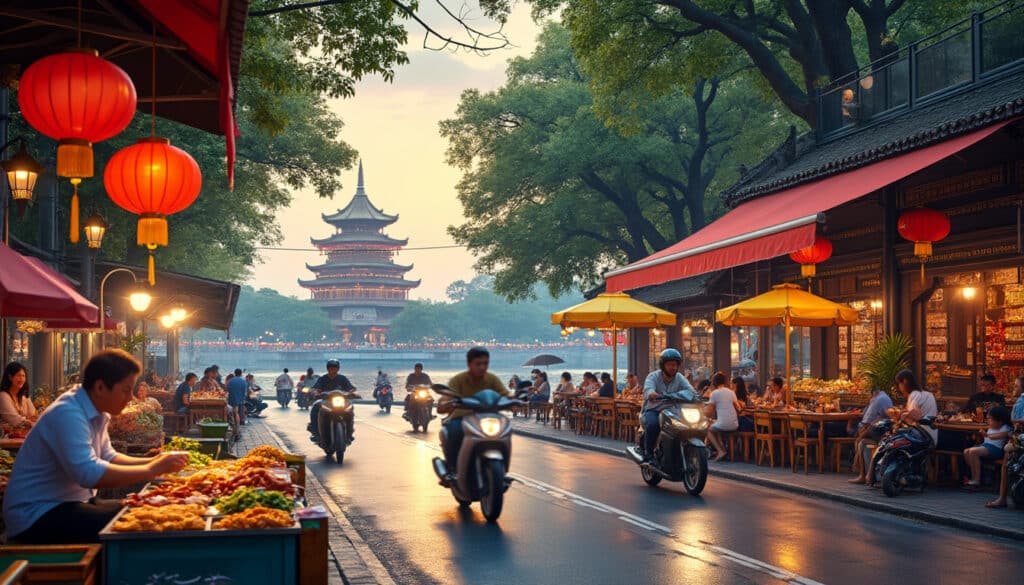
Fun Facts & Curiosities About Hanoi
Hanoi, the vibrant capital of Vietnam, is a fascinating mix of rich history, unique traditions, and modern progression. From its celebrated street food scene to the captivating water puppet shows, Hanoi is both a city of lakes and legends. Visitors…
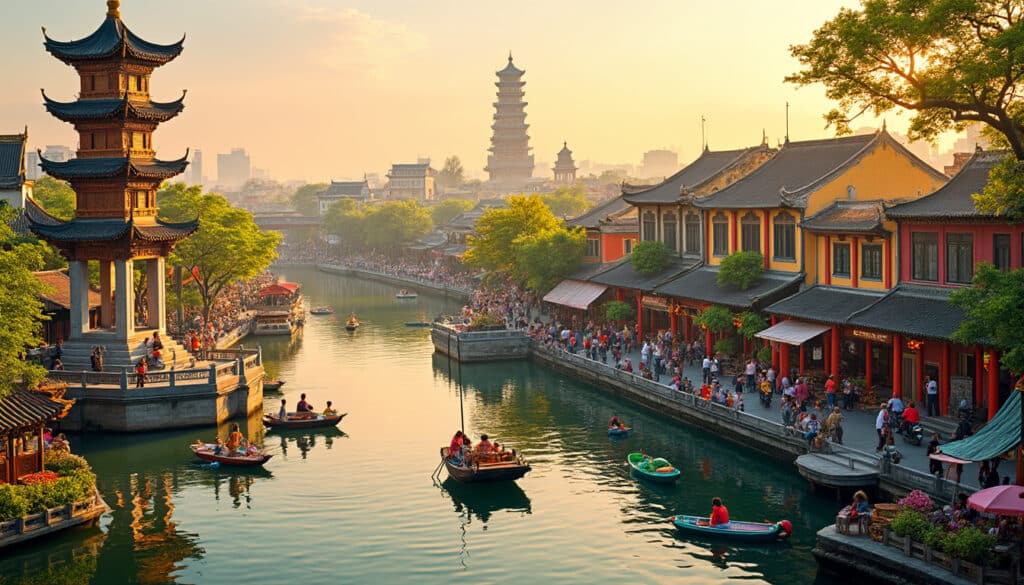
Architecture and urban features of Hanoi
With a rich tapestry of cultures and historical evolution, Hanoi stands as a captivating testament to Vietnam’s architectural diversity. This city’s allure doesn’t just lie in its remarkable history but in its unique blend of oriental and French-style architecture that…
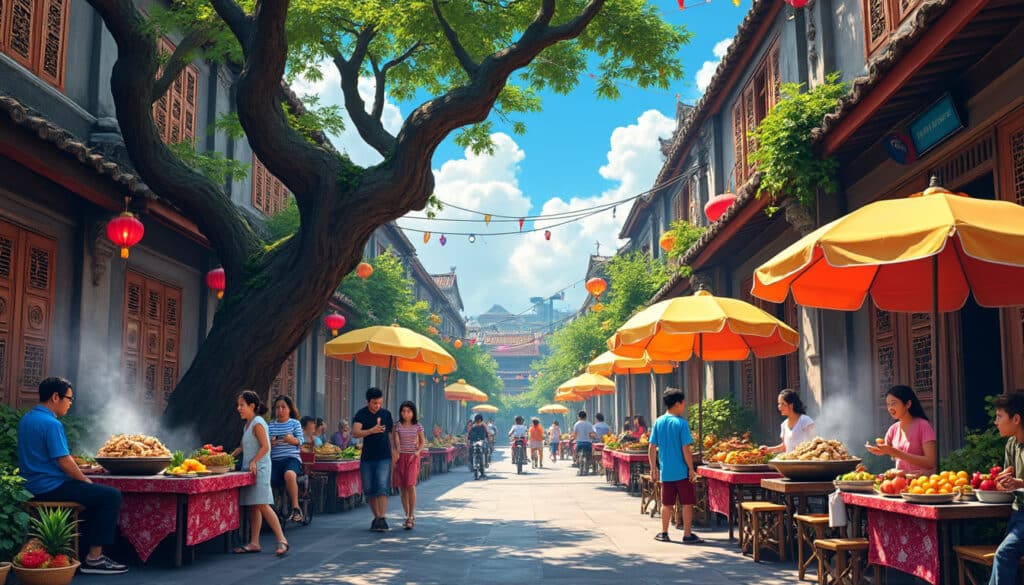
Experience the daily life in Hanoi, a city brimming with vibrant charm and historical depth. As you navigate through the bustling streets, the harmonious blend of the old and new reveals itself in every corner. From savoring delectable street food…
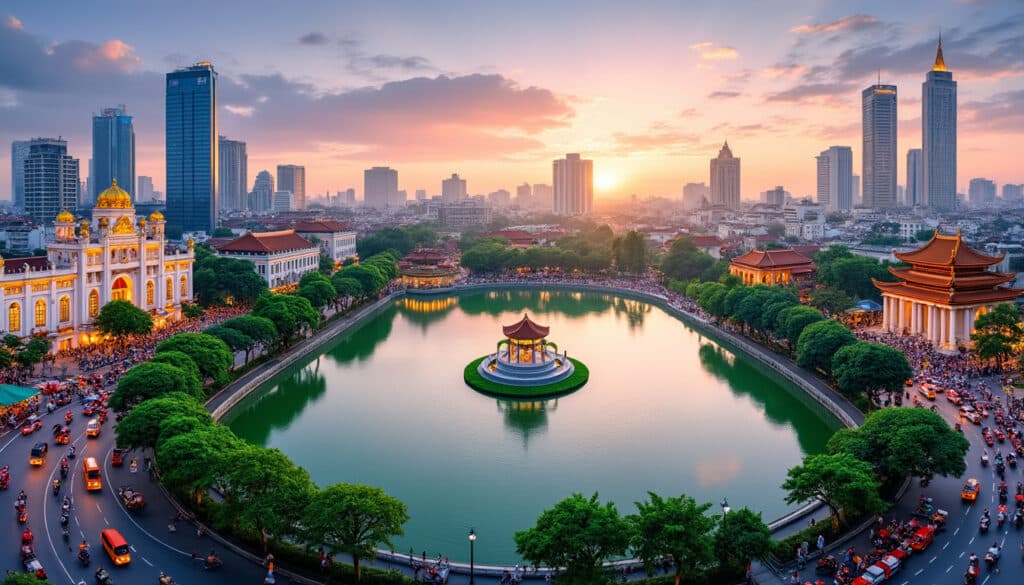
Demographics and geography of Hanoi
The vibrant city of Hanoi, the capital of Vietnam, is not just the political heart but also a pulsating hub of culture, history, and modernity. With a rich tapestry of over a thousand years of evolution, the city has seen…

Holidays and celebrations in Hanoi
Hanoi, the pulsating heart of Vietnam, offers a tapestry of vibrant festivals and celebrations that reflect its rich cultural heritage and traditions. Throughout the year, local and international visitors witness an enchanting blend of the past and present, as the…

Language and spelling of Hanoi
Hanoi, the vibrant capital of Vietnam, is a melting pot of cultures, histories, and languages. It’s not just a city known for its charming architecture or vibrant street life, but also for its linguistic diversity that reflects its historical tapestry.…

Local tips for tourists in Hanoi
Exploring Hanoi, Vietnam’s thousand-year-old capital, is a journey into a world where ancient traditions and modern dynamism converge. With its rich cultural heritage, vibrant street life, and aromatic cuisine, Hanoi captivates every traveler. Yet, navigating this bustling city can be…

Names, flags, and identity of Hanoi
In the heart of Vietnam, Hanoi stands as a testament to the cultural and historical richness that has evolved over millennia. The names, flags, and identity of this vibrant city are not just labels or symbols, but threads woven into…

As the vibrant capital of Vietnam, Hanoi is a city that offers an intriguing blend of history, modernity, and cultural diversity. Understanding the rhythm of this bustling metropolis goes beyond its rich traditions and lively street scenes. The way time…

Unusual facts and social issues in Hanoi
Hanoi, the bustling capital of Vietnam, is a city that fuses ancient traditions with rapid modernity. Known for its rich cultural heritage, Hanoi’s unique blend of history and progression offers a fascinating backdrop for unusual facts and social dynamics that…
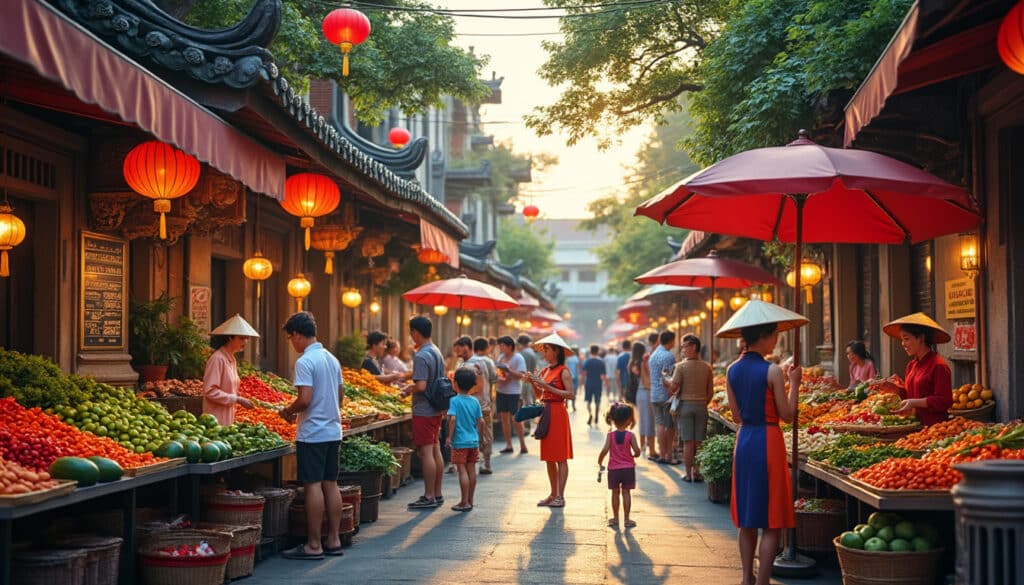
What does Hanoi look, smell, feel like?
Experiencing Hanoi is like stepping into a symphony of vibrant images, lively sounds, and delightful scents. Nestled between historic roots and modern hustle, Vietnam’s capital offers a unique sensory journey. Whether you’re wandering through the alleys brimming with local art…



